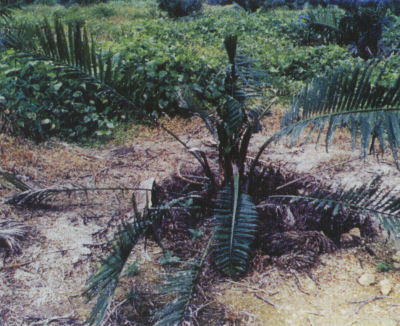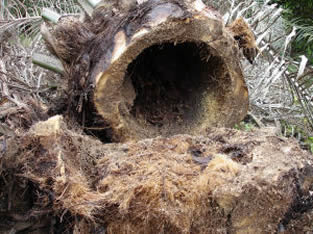

A Shattered Dream
Chapter 3
Page 1
Daunted by Pests and Incurable Palm Diseases
Rhinoceros beetles
When I took over the plantation from my brother, little did I know anything about oil palm pests and diseases. Neither had I heard anything about them from my brother nor from farmers working in the plantation.
During the first six to nine months after replanting there were no signs of young palms being attacked by pests or diseases and everything was going smoothly. However, this feeling of complacency soon ended when I noticed that in some palms the new spears failed to open and began to dieback. Also some of the newly opened fronds snapped.

Attacked by Rhinoceros Beetles
Upon closer examination I could see clusters of chewed materials and also small boreholes around the frond bases. The farmers then told me that these were made by rhinoceros beetles! And I could use a wire-hook to extract them from the boreholes!
My immediate reaction was to find a suitable method to eliminate this menace. The farmers there told me to use a brand of banned potent insecticide to spray on to the inflected palms. Others told me to employ workers to catch them in the evenings!
I was lucky, as I did not have to look far and wide to find the right solution. One of my nephews knows an old friend of his who works in S. Darby Plantations and I was introduced to a biological control method adopted by them.
This method uses Sime RB Pheromone, a slow release ethyl-4-methyloctanoate to lure rhnoceros beetles to traps. The Pheromone was first developed in South Africa to trap rhinoceros beetles in oil palms and coconut palms.
The trap consists of an 18-litre bucket into which a black painted matter vane is half inserted. A sachet of Sime RE Pheromone is attached to a hole at the top of the vane.


The Traps
The whole assembly is hung 3 - 4 meters above ground level. Forty traps were purchased and they were placed within the plantation at approximately one trap per 1 hectare. The Pheromone sachet needs to be replaced in about every three months.
All these beetles were trapped only in one bucket
The results were phenomenal with over a hundred beetles trapped in some buckets only after about two weeks in use.
The attacks on the young oil palm trees slowly became less after the installation of the Pheromone traps and after over a year in use (by mid 2003) I stopped replacing the Pheromone sachets.
So that ended my fight against the rhinoceros beetles. But I am still wondering why the beetles only attacked my plantation and other similar plantations around my area were spared! A farmer told me, "You caught so many of them and now there is none left in the whole of Pagoh!"
Incurable Oil Palm Diseases
Well before I started oil palm replanting in our plantation, I was aware that through extensive R&D over the years, Malaysia has built a successful national brand in palm oil.
But four years after replanting I discovered that a couple of palm trees suddenly withered and fell. I wasted no time in trying to find out the disease that caused the young palms to die unexpectedly. I first approached MPOB for help and was glad that I was provided with all the technical papers published thus far by MPOB.
1. Wet Stem Rot Disease
I was told by MPOB the disease afflicting some of the young palms was due to an incurable disease called Wet Stem Rot (WSR) which only attacks young palms of less than five years old. According to MPOB, the pathogen that causes this disease has still not been identified!
The symptoms of this disease begin with the older fronts turning brown. But the disease quickly spreads and within a couple of months the whole palm is dead.


Young palm dead due to WSR A big hollow
Cutting the palm down, one can see a big hollow in the trunk extending from the base to the crown. What remains is a chunk of loose and soft fibers at its base.
As the disease is incurable and confined only to young plants, all big oil palm plantation owners have made provisions during replanting. Some extra seedlings are planted in between rows and they would used to replace those that have been afflicted with WSR disease.
go to page 2